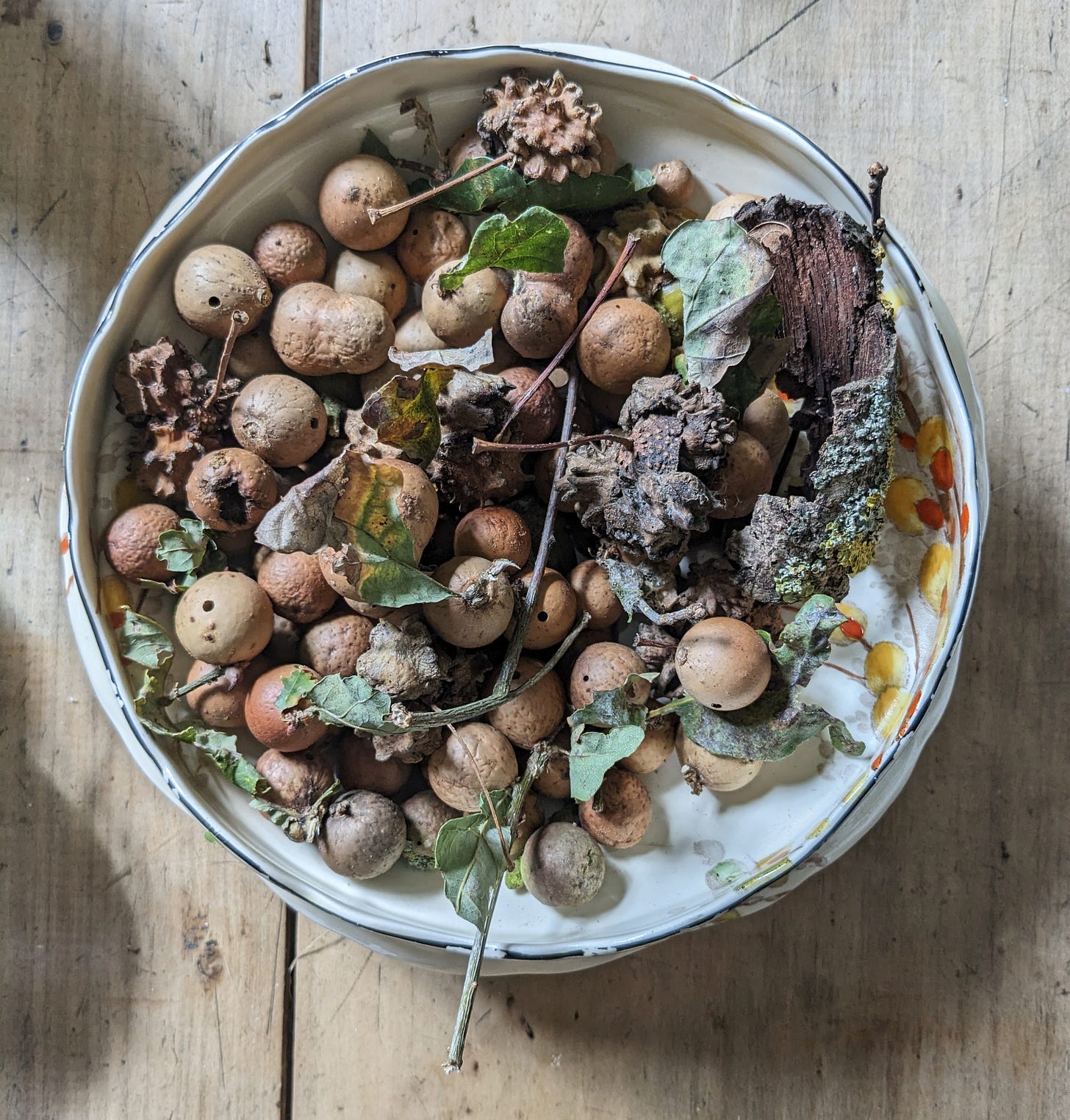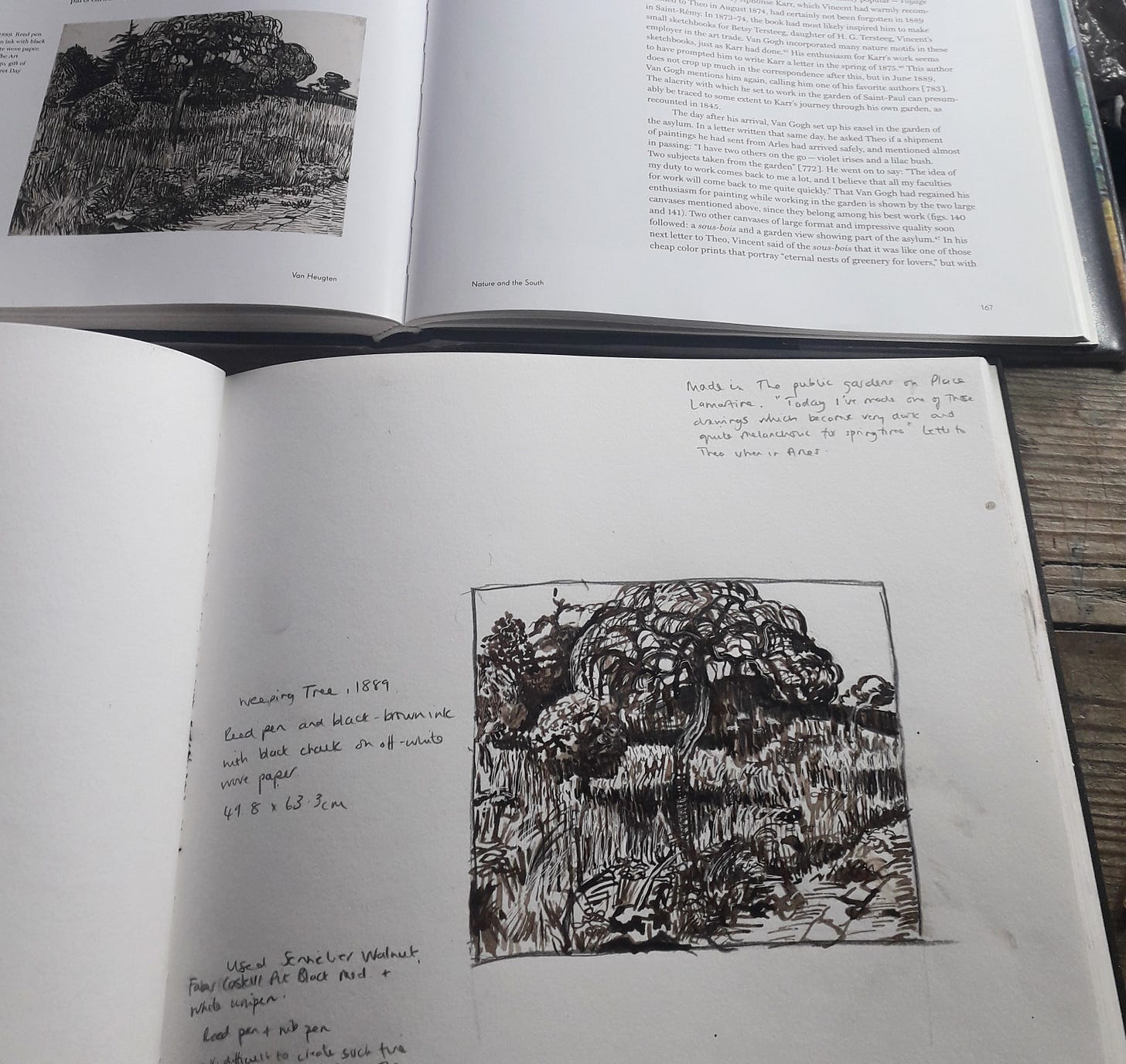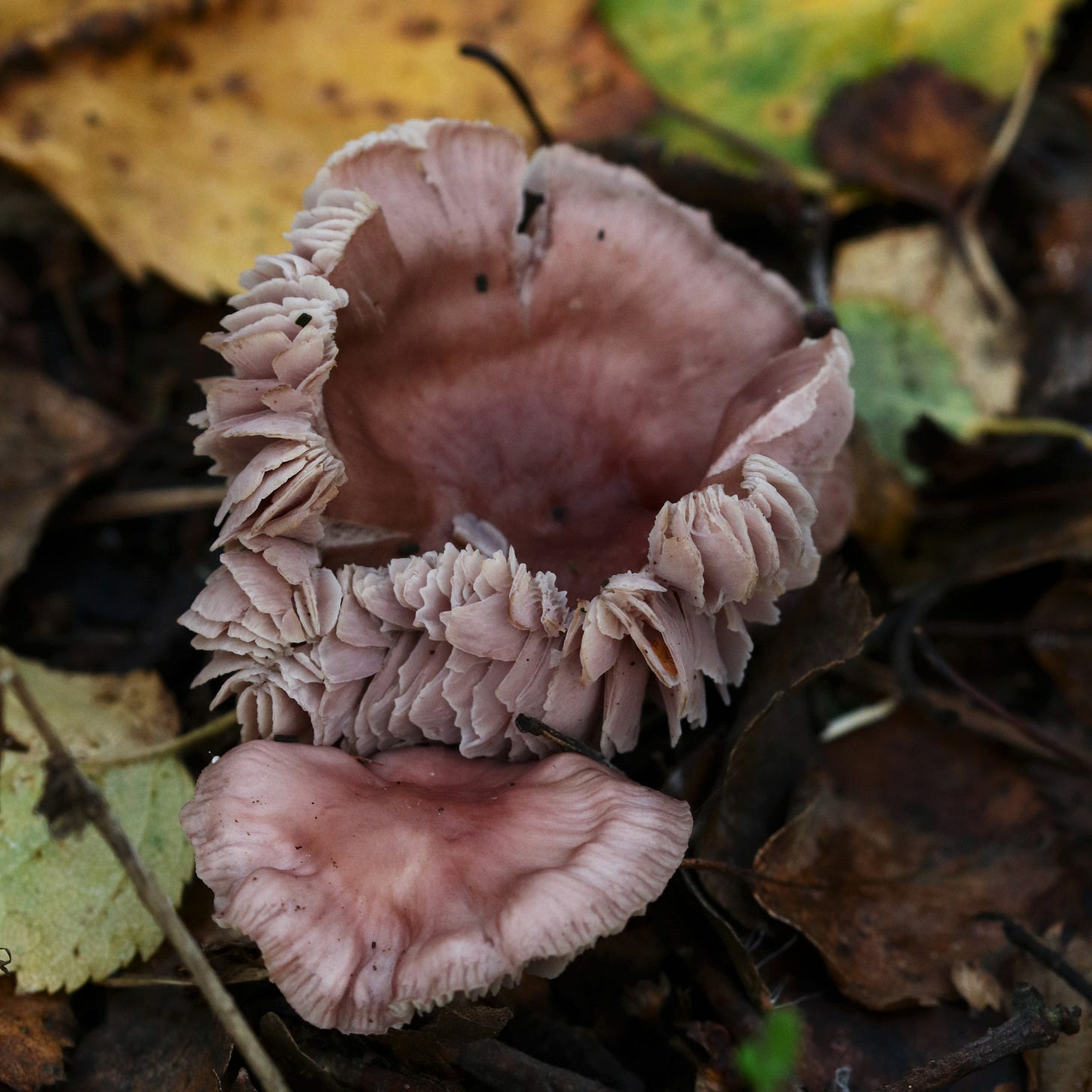Remember to only pick galls with the holes
…you are sure to find oak galls! I have always rather fancied making my own oak gall ink, but have only ever found a handful. This year, however, while sitting drawing under an old oak on Wortham Ling, I spotted a few nestled among the leaves, and once I had “got my eye in” I realised that they were all over the tree and began filling my pockets.
Oak galls are formed by a tiny parasitic female wasp, Andricus kollari , who lays her eggs on the penduculate oak by injecting a chemical that triggers the creation of the gall. This develops into a protective shell around the larvae. You can tell they have hatched by the small hole that appears in the case and so you must be careful when collecting them to only chose those that have an escape route.
It seems that these galls are more prevalent in trees that have suffered some environmental stress. The Ling is mostly free draining, sandy soil and following the periods of prolonged drought we have experienced in the last couple of years, the number of galls have proliferated.
I have chosen to make ink from the round galls, which make a darker ink, but there are also the knobbly Knoppers, which deform the acorns as the eggs are laid on the freshly pollinated flowers, but these make a paler ink.
Knopper galls
Oak gall ink dates from the Roman period, but was extensively used from medieval times and was the ink used to sign the Magna Carta. It does not fade, and penetrates the paper, making it indelible. It was used by Da Vinci in his notebooks, on Bach’s musical scores and by Rembrandt and Van Gogh in their drawings.
My intention is to use this ink to create drawings of the trees from which the ink galls came. I am increasingly drawn to using materials that have a connection to place and the creation and use of this ink seems an ideal place to start.
To begin to get used to its qualities, I decided to look closely at the drawings of Van Gogh.
Copying the work of other artists is not about cheating! By following their actions, the line of the pen, you are able to appreciate not only their skill, but also their thought processes.
You can see the results in the drawings below and in the short film I made. I should also say that inkeeping with this project, I decided to make reed pens, just as Van Gogh would have used to make the drawings. These are beautifully yielding to draw with and I love the slight unpredictability of they marks they make.
Using the oak gall ink and a reed pen
If you would like to try to make your own ink, this is the recipe I used:
1770 Recipe for Oak Gall Ink
2oz of oak galls, crushed. I used a strong bag and bashed with a hammer and then ground them more finely in a mortar and pestle.
Pour one pint of distilled water onto the crushed galls a leave for 24 hours.
Strain through a muslin cloth.
Add one ounce of ferrous sulphate (available from the garden centre, which is considerably cheaper.
Add half an ounce of gum arabic. This adds lustre and substance. You are now ready to draw! The ink changes with dark brown to rich, blue black within seconds as it oxidises.
And if you don't fancy making your own, I suggest you try Cornelissen who sell several original recipes, in beautiful bottles, including recipes used by Jane Austen and Isaac Newton - who could resist!
Something to listen to …
A new podcast discovery is “As the Season Turns”, presented by the nature writer and creator of the Seasonal Almanac, Lia Leendertz. Each episode is released at the beginning of the month and helps us to notice what is happening in nature, in the garden and in the skies. A gentle and enlightening listen. In this episode find out what Monkey Steps are!
Birch Polypore
Something to read…
Not a book this time, but a poem by the Scottish poet, Norman McCaig. As the days grow shorter , he describes an encounter that brings light in darkness.
Toad
Stop looking like a purse. How could a purse
squeeze under the rickety door and sit,
full of satisfaction, in a man's house?
You clamber towards me on your four corners -
right hand, left foot, left hand, right foot.
I love you for being a toad,
for crawling like a Japanese wrestler,
and for not being frightened.
I put you in my purse hand, not shutting it,
and set you down outside directly under
every star.
A jewel in your head? Toad,
you've put one in mine,
a tiny radiance in a dark place.
Norman MacCaig
If you want to hear more about toads, the poem is featured in this delightful episode of Natural Histories.
If you are a subscriber, you might have missed my last post on drawing out in the woods. Unfortunately, owing to a brain foggy with flu, I managed to send to only paid subscribers…So do have a look if you fancy a few quiet moments. I tried to resend it, but all attempts failed…
Thank you for joining me and I look forward to your company again in a couple of weeks.
Pink Waxcaps are now emerging under the oaks on the Ling











In an age when you can buy just about everything, I love that you are not only making your own ink out of these galls--but that you are making a study of them by trying to understand and observe how Van Gogh used them--then use the ink to draw the trees that helped create the medium. It gives such meaning to place-based art. I am curious about the reed pen...I watched the video, and I’m guessing such an implement is more precision-focused vs flowing? I’m about to start a writing/art project that requires an implement skewing towards the flowing kind, but I’d like it to be something I craft myself, and I’d also like to try my luck at making some for the project as well now that I’ve been inspired by you. I’m not sure there are any galls to be found here in the Eastern U.S. however... Thank you for such a lovely share!
I love your drawings in this ink! And I’ve always loved these Van Gogh ones but had no idea they were created in gall ink. I’d love to try this so am going to see if I can find any on Hampstead Heath. Thank you Deborah! Xx